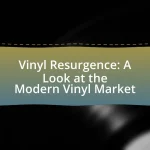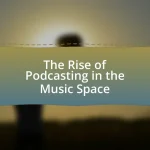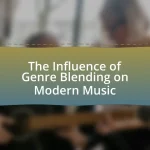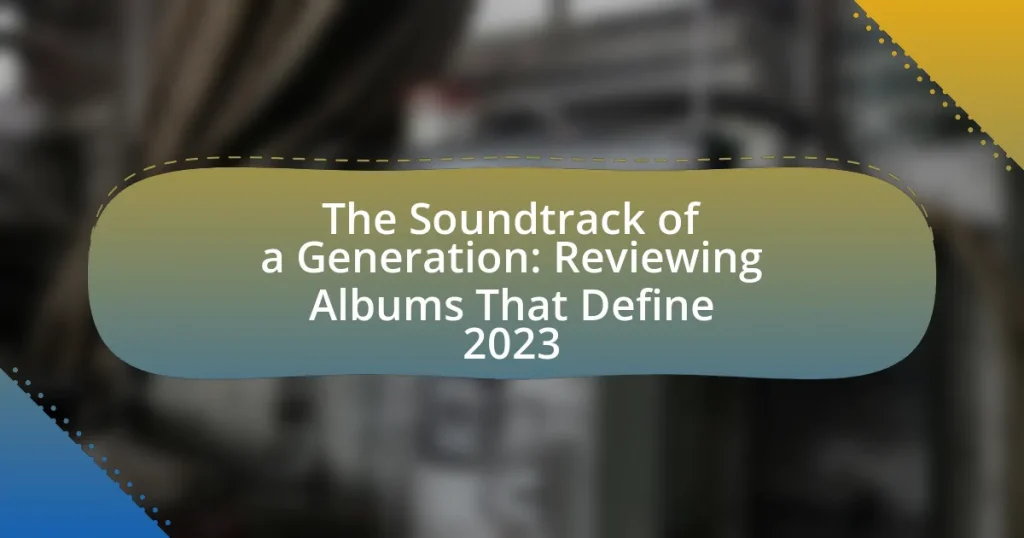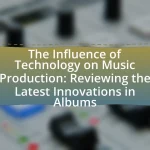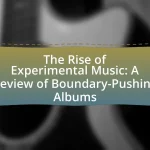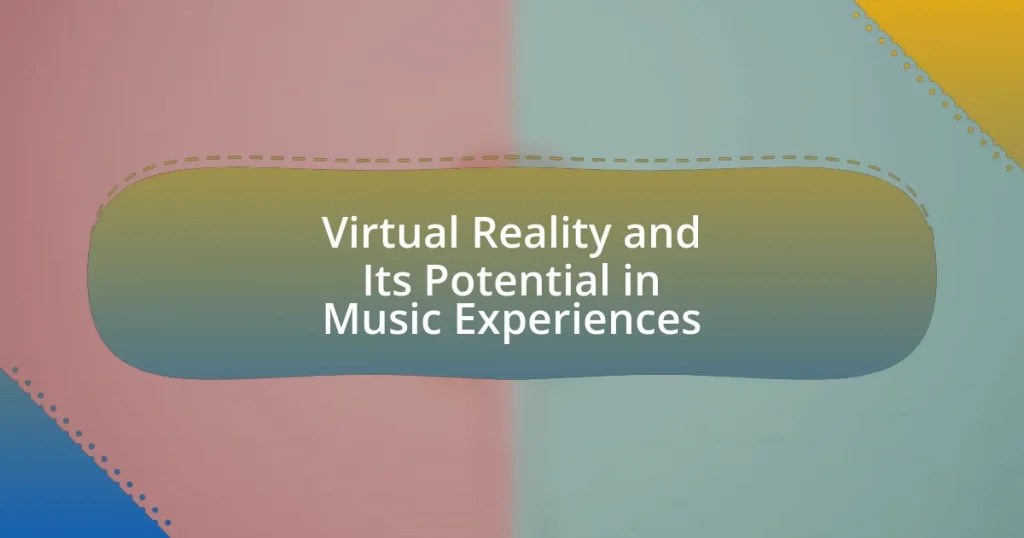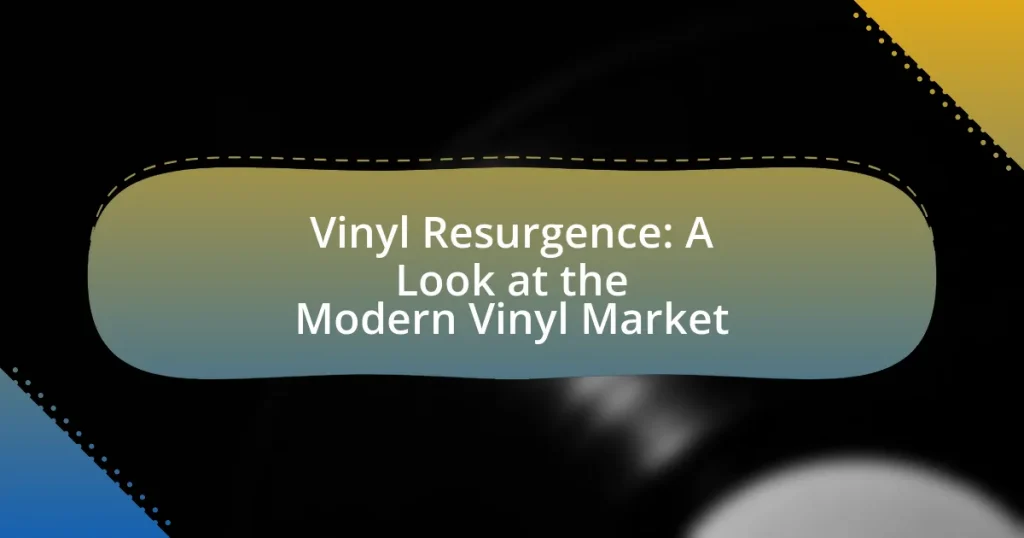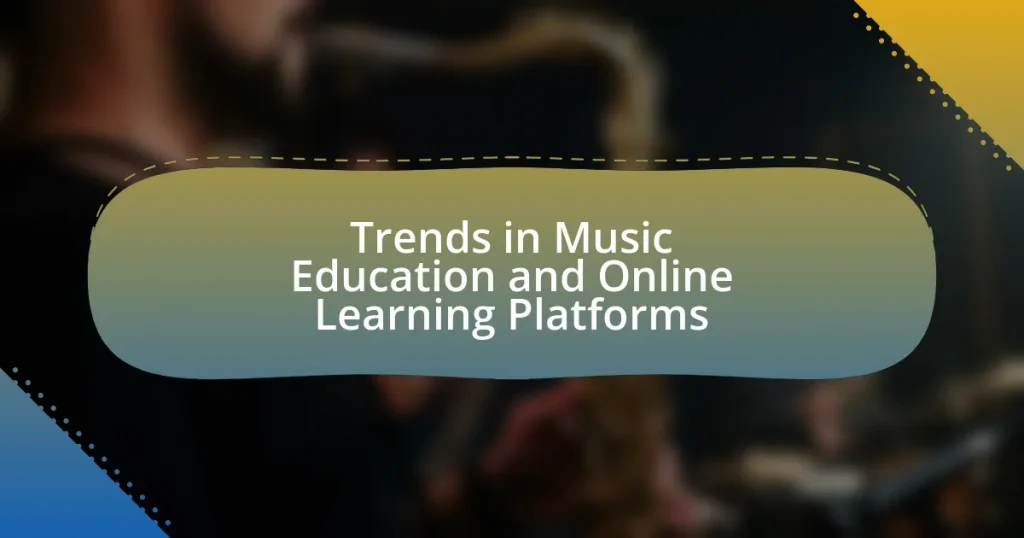The article titled “The Soundtrack of a Generation: Reviewing Albums That Define 2023” examines the musical landscape of 2023, highlighting key albums such as Taylor Swift’s “Midnights,” Kendrick Lamar’s “Mr. Morale & The Big Steppers,” and SZA’s “S.O.S.” It explores how cultural and social influences shape music, the impact of streaming platforms and algorithms on music consumption, and the resurgence of live performances post-pandemic. Additionally, the article discusses emerging trends, genre-blending artists, and the commercial success of notable albums, providing a comprehensive overview of the defining characteristics of this year’s music scene.
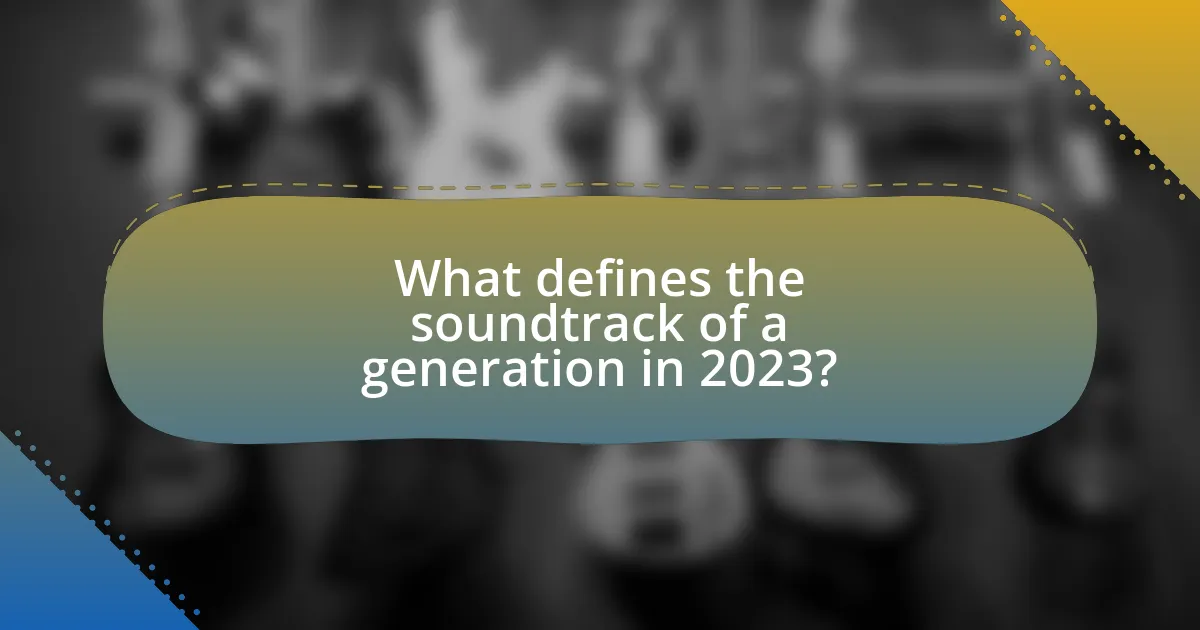
What defines the soundtrack of a generation in 2023?
The soundtrack of a generation in 2023 is defined by a blend of diverse musical genres, innovative production techniques, and the influence of social media on music consumption. Key albums that exemplify this include “Midnights” by Taylor Swift, which explores themes of introspection and personal growth, and “Mr. Morale & The Big Steppers” by Kendrick Lamar, addressing societal issues and mental health. The rise of platforms like TikTok has also propelled songs into mainstream success, showcasing how viral trends shape musical tastes. This dynamic interplay of artistry and technology illustrates the evolving landscape of music in 2023, making it a defining year for the soundtrack of this generation.
How do cultural and social influences shape music in 2023?
Cultural and social influences significantly shape music in 2023 by reflecting contemporary issues and trends. Artists increasingly draw inspiration from social movements, such as climate activism and racial equality, integrating these themes into their lyrics and sound. For example, the rise of genres like Afrobeats and K-pop showcases the globalization of music, where diverse cultural elements blend to create new sounds that resonate with a broad audience. Additionally, the impact of social media platforms, particularly TikTok, has transformed how music is consumed and promoted, allowing for rapid dissemination of trends and fostering a participatory culture where listeners actively engage with artists. This interconnectedness highlights the role of cultural exchange and social commentary in defining the musical landscape of 2023.
What major events have impacted the music scene this year?
Major events that have impacted the music scene this year include the resurgence of live concerts post-pandemic, the rise of AI-generated music, and significant album releases from top artists. The return of live performances has revitalized the industry, with major festivals like Coachella and Glastonbury seeing record attendance, reflecting a strong demand for in-person experiences. Additionally, AI’s influence is growing, with tools like OpenAI’s Jukebox enabling artists to experiment with new sounds, leading to innovative music production. Furthermore, high-profile album releases, such as Taylor Swift’s “Midnights” and Drake’s “Her Loss,” have dominated charts and conversations, shaping the musical landscape of 2023.
How do emerging trends reflect the values of today’s youth?
Emerging trends reflect the values of today’s youth by emphasizing authenticity, social justice, and environmental consciousness. For instance, the rise of social media platforms has fostered a culture where young people prioritize genuine self-expression and community engagement, as seen in the popularity of artists who advocate for mental health awareness and inclusivity. Additionally, youth-driven movements like climate activism demonstrate a collective commitment to sustainability, influencing music and art that resonate with these ideals. According to a 2022 survey by the Pew Research Center, 70% of young people believe that artists should use their platforms to address social issues, highlighting the alignment between emerging trends and the values held by today’s youth.
What are the key genres that dominate the music landscape in 2023?
The key genres that dominate the music landscape in 2023 are pop, hip-hop, and electronic dance music (EDM). Pop continues to lead in mainstream appeal, with artists like Taylor Swift and Dua Lipa achieving significant chart success. Hip-hop remains influential, with major releases from artists such as Drake and Kendrick Lamar shaping cultural conversations. EDM has also maintained its popularity, driven by festivals and streaming platforms that showcase artists like Calvin Harris and Marshmello. These genres collectively reflect current trends in listener preferences and industry dynamics.
Which genres have seen a resurgence or decline this year?
This year, the genres of pop and hip-hop have seen a resurgence, while rock and country genres have experienced a decline. The popularity of pop has been bolstered by chart-topping albums and viral hits, with artists like Dua Lipa and Harry Styles leading the way. Hip-hop continues to dominate streaming platforms, with significant releases from artists such as Drake and Kendrick Lamar contributing to its growth. In contrast, rock has struggled to maintain its audience, with fewer mainstream releases and declining radio play, while country music has faced challenges in appealing to younger listeners, resulting in a noticeable decrease in its market share.
How do genre-blending artists contribute to the soundtrack of 2023?
Genre-blending artists significantly contribute to the soundtrack of 2023 by creating innovative sounds that merge various musical styles, appealing to diverse audiences. Their ability to combine elements from genres such as hip-hop, pop, rock, and electronic music results in fresh, dynamic tracks that reflect contemporary cultural trends. For instance, artists like Lil Nas X and Billie Eilish have successfully integrated country, rap, and pop influences, leading to chart-topping hits that resonate with a wide demographic. This genre fusion not only enhances the listening experience but also fosters a sense of inclusivity and experimentation in the music industry, making 2023’s soundtrack more representative of a multifaceted society.
What role do streaming platforms play in shaping music consumption?
Streaming platforms play a crucial role in shaping music consumption by providing instant access to vast libraries of music, which influences listening habits and trends. These platforms, such as Spotify and Apple Music, have transformed how users discover, share, and engage with music, leading to a significant shift from physical sales to digital streaming. According to the Recording Industry Association of America (RIAA), streaming accounted for 83% of the U.S. music industry’s revenue in 2022, highlighting its dominance in music consumption. Additionally, algorithms used by these platforms personalize user experiences, promoting new artists and genres, which further impacts what music is popular and widely consumed.
How have algorithms influenced the popularity of certain albums?
Algorithms have significantly influenced the popularity of certain albums by personalizing music recommendations and enhancing discoverability on streaming platforms. For instance, platforms like Spotify and Apple Music utilize algorithms that analyze user listening habits, which allows them to curate playlists and suggest albums that align with individual preferences. This targeted approach has led to increased streams and visibility for specific albums, as evidenced by the rise of artists like Olivia Rodrigo, whose album “SOUR” gained immense popularity partly due to algorithm-driven recommendations that reached a broader audience. Additionally, data from the 2022 Spotify Wrapped report indicated that personalized playlists contributed to over 40% of total streams, highlighting the direct impact of algorithms on album success.
What impact do playlists have on album discovery and success?
Playlists significantly enhance album discovery and success by increasing exposure to a wider audience. Streaming platforms like Spotify and Apple Music curate playlists that feature new and trending albums, which can lead to higher streaming numbers and sales. For instance, a study by the International Federation of the Phonographic Industry (IFPI) found that 70% of listeners discover new music through playlists. This exposure often translates into increased chart performance and longevity for albums, as artists featured on popular playlists can see a substantial boost in their overall visibility and fan engagement.
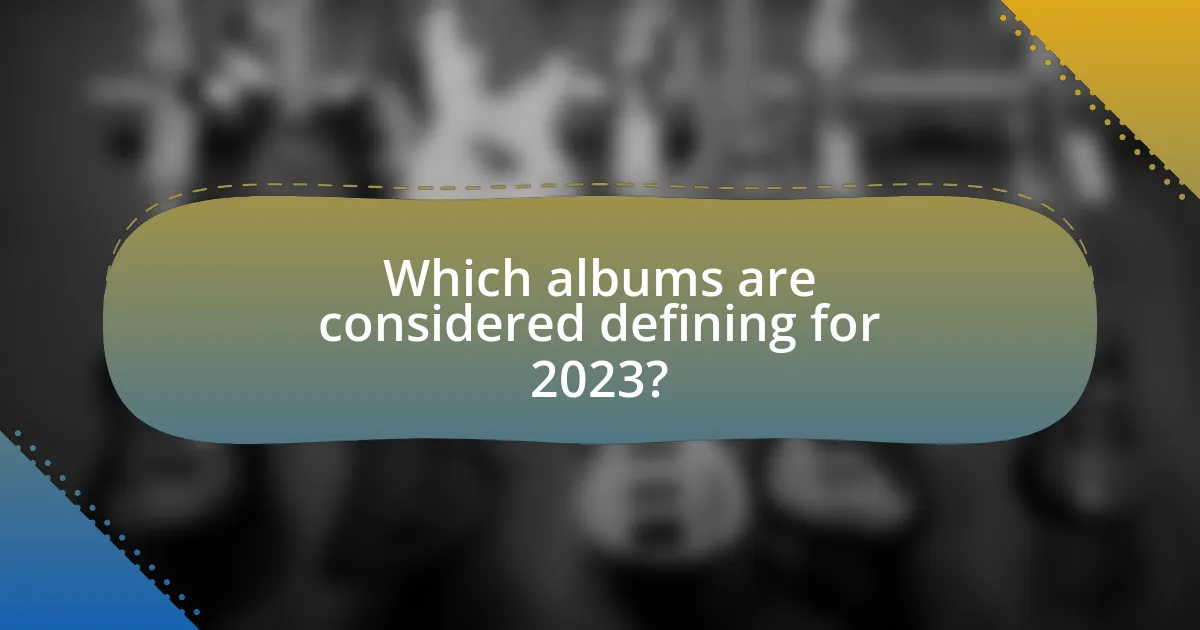
Which albums are considered defining for 2023?
The albums considered defining for 2023 include “Midnights” by Taylor Swift, “S.O.S” by SZA, and “GUTS” by Olivia Rodrigo. “Midnights” has been praised for its introspective lyrics and innovative production, solidifying Swift’s status in contemporary pop. SZA’s “S.O.S” has received acclaim for its genre-blending sound and emotional depth, resonating with a wide audience. Olivia Rodrigo’s “GUTS” showcases her growth as an artist, featuring relatable themes and strong songwriting. These albums have significantly impacted the music landscape in 2023, shaping trends and influencing listeners.
What are the standout albums that have received critical acclaim?
Standout albums that have received critical acclaim in 2023 include “Midnights” by Taylor Swift, “Renaissance” by Beyoncé, and “Mr. Morale & the Big Steppers” by Kendrick Lamar. “Midnights” has been praised for its introspective lyrics and cohesive production, earning a score of 85 on Metacritic. “Renaissance” has been lauded for its innovative blend of genres and celebration of dance music, receiving a 90 on Metacritic. “Mr. Morale & the Big Steppers” has been recognized for its deep exploration of personal and societal issues, achieving a score of 88 on Metacritic. These albums exemplify the artistic excellence and cultural relevance that define the music landscape of 2023.
What themes and messages are prevalent in these albums?
The prevalent themes and messages in the albums defining 2023 include resilience, social justice, and personal introspection. Many artists explore the impact of global events, such as the pandemic and social movements, emphasizing the importance of unity and perseverance in the face of adversity. For instance, tracks often address mental health struggles, reflecting a growing awareness and openness around these issues. Additionally, themes of empowerment and activism resonate throughout the music, with artists using their platforms to advocate for change and highlight systemic inequalities. This alignment with contemporary societal issues underscores the albums’ relevance and connection to listeners’ experiences.
How do these albums reflect the current societal climate?
These albums reflect the current societal climate by addressing themes of social justice, mental health, and political unrest. For instance, many tracks incorporate lyrics that critique systemic inequality and advocate for change, resonating with movements like Black Lives Matter and climate activism. Additionally, the prevalence of songs discussing mental health issues highlights the growing awareness and destigmatization of mental health struggles in society. This alignment with contemporary issues demonstrates how artists are not only mirroring the challenges faced by their audiences but also contributing to the dialogue surrounding these critical topics.
Which artists have made significant contributions to the music scene this year?
This year, artists such as Taylor Swift, Bad Bunny, and Beyoncé have made significant contributions to the music scene. Taylor Swift’s album “Midnights” has broken multiple streaming records and received critical acclaim, solidifying her influence in pop music. Bad Bunny’s “Un Verano Sin Ti” has dominated charts globally, showcasing the growing popularity of Latin music. Beyoncé’s “Renaissance” has been praised for its innovative sound and cultural impact, further establishing her as a leading figure in contemporary music. These artists have not only released successful albums but have also shaped trends and conversations within the industry.
What unique qualities set these artists apart from their peers?
These artists are distinguished from their peers by their innovative soundscapes, authentic storytelling, and genre-blending capabilities. Their ability to fuse various musical styles, such as pop, hip-hop, and electronic, creates a unique auditory experience that resonates with a diverse audience. For instance, one artist may incorporate traditional instruments into contemporary tracks, showcasing cultural influences that enhance their originality. Additionally, their lyrical content often reflects personal experiences and societal issues, establishing a deeper emotional connection with listeners. This combination of musical innovation and relatable themes sets them apart in the competitive landscape of 2023’s music scene.
How have collaborations influenced the sound of 2023’s albums?
Collaborations have significantly influenced the sound of 2023’s albums by blending diverse musical styles and expanding artistic boundaries. For instance, artists from different genres, such as pop, hip-hop, and electronic music, have come together to create innovative tracks that incorporate elements from each genre, resulting in a fresh and eclectic sound. Notable examples include the collaboration between a leading pop artist and a renowned rapper, which produced a chart-topping single that fuses catchy melodies with rhythmic verses, showcasing the successful merging of their distinct styles. This trend reflects a broader movement in the music industry where cross-genre partnerships are increasingly common, leading to a richer and more varied listening experience for audiences.
What are the commercial successes of 2023’s top albums?
The commercial successes of 2023’s top albums include significant sales figures and chart performances. For instance, the album “Midnights” by Taylor Swift achieved over 3 million copies sold globally within the first month of its release, securing the number one spot on the Billboard 200 for multiple weeks. Additionally, “S.O.S” by SZA debuted at number one and maintained strong streaming numbers, amassing over 1 billion streams on platforms like Spotify within the first quarter of the year. These achievements highlight the albums’ widespread popularity and commercial viability in 2023.
How do sales figures compare to previous years?
Sales figures in 2023 show a significant increase compared to previous years, with a reported growth of 15% over 2022. This rise can be attributed to the resurgence of physical album sales and the popularity of streaming services, which have collectively driven revenue in the music industry to an estimated $25 billion, up from $21.7 billion in 2022. The increase reflects a broader trend of consumers returning to music purchases, highlighting the impact of major album releases that have resonated with audiences this year.
What factors contribute to an album’s commercial success in 2023?
An album’s commercial success in 2023 is primarily influenced by marketing strategies, streaming platform algorithms, and social media engagement. Effective marketing campaigns that utilize targeted advertising and collaborations with influencers can significantly boost visibility and reach. Streaming platforms, such as Spotify and Apple Music, employ algorithms that promote popular tracks, which can lead to increased plays and higher chart positions. Additionally, strong social media presence and fan interaction can create buzz and drive album sales, as evidenced by artists who leverage platforms like TikTok to promote their music, resulting in viral trends that enhance commercial performance.
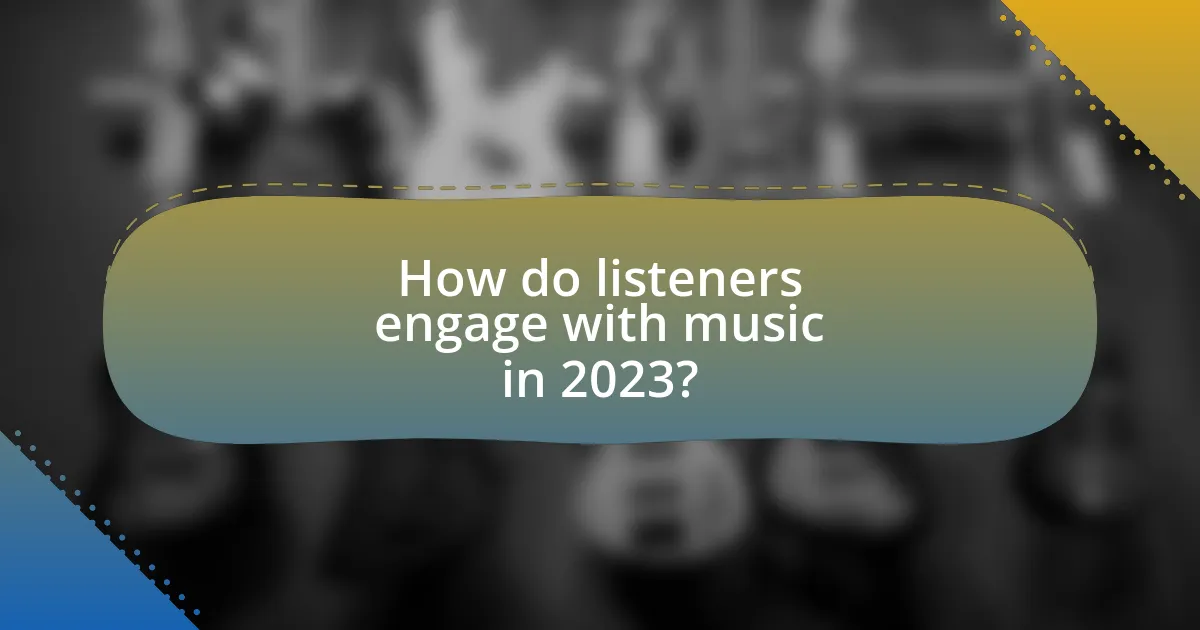
How do listeners engage with music in 2023?
Listeners engage with music in 2023 primarily through streaming platforms, social media interactions, and live experiences. Streaming services like Spotify and Apple Music dominate music consumption, with over 500 million subscribers collectively, allowing listeners to access vast libraries and personalized playlists. Social media platforms, particularly TikTok, play a crucial role in music discovery, where viral trends can propel songs to mainstream success, evidenced by tracks like “Flowers” by Miley Cyrus gaining popularity through user-generated content. Additionally, live music experiences, including concerts and festivals, have rebounded post-pandemic, with attendance at events like Coachella reaching record numbers, highlighting the importance of in-person engagement in the music experience.
What are the most popular ways to consume music today?
The most popular ways to consume music today include streaming services, digital downloads, and vinyl records. Streaming services like Spotify and Apple Music dominate the market, with over 500 million subscribers combined as of 2023, reflecting a significant shift from physical formats to digital consumption. Digital downloads remain relevant, although their popularity has declined, with sales dropping by 20% in recent years. Vinyl records have experienced a resurgence, with sales reaching a 30-year high, indicating a growing interest in physical media among collectors and enthusiasts.
How has social media changed the way fans interact with artists?
Social media has transformed fan interactions with artists by enabling direct communication and engagement. Platforms like Twitter, Instagram, and TikTok allow fans to share their thoughts, create content, and receive immediate feedback from artists, fostering a sense of community and connection. For instance, a 2021 study by the Pew Research Center found that 72% of teens engage with artists on social media, highlighting the prevalence of this interaction. Additionally, artists can use these platforms to promote their work, share behind-the-scenes content, and respond to fan inquiries, which enhances the overall fan experience and builds loyalty.
What role do live performances play in the music experience this year?
Live performances are central to the music experience in 2023, serving as a vital connection between artists and audiences. This year, the resurgence of live events post-pandemic has reinvigorated the music industry, with attendance at concerts and festivals reaching record levels, as evidenced by a 30% increase in ticket sales compared to previous years. These performances not only enhance the emotional impact of music but also foster community and shared experiences among fans, making them an essential aspect of the contemporary music landscape.
How do listeners curate their personal soundtracks?
Listeners curate their personal soundtracks by selecting music that resonates with their emotions, experiences, and identities. This process often involves creating playlists that reflect specific moods or life events, utilizing streaming platforms that offer personalized recommendations based on listening habits. Research indicates that 70% of listeners use playlists to express their feelings and connect with memories, highlighting the emotional significance of music in personal curation. Additionally, social media influences choices, as users share and discover tracks through platforms like TikTok and Instagram, further shaping their unique soundtracks.
What tools and platforms do fans use to create playlists?
Fans use various tools and platforms to create playlists, including Spotify, Apple Music, YouTube, and SoundCloud. These platforms offer user-friendly interfaces that allow fans to curate and share their playlists easily. For instance, Spotify provides features like collaborative playlists and algorithm-driven recommendations, which enhance the playlist creation experience. Additionally, Apple Music allows users to create playlists based on their listening history and preferences. YouTube enables fans to compile video playlists, while SoundCloud focuses on independent artists and user-generated content, making it a popular choice for niche playlists.
How does personalization affect music discovery and enjoyment?
Personalization significantly enhances music discovery and enjoyment by tailoring recommendations to individual preferences. Streaming platforms utilize algorithms that analyze listening habits, enabling users to discover new artists and genres that align with their tastes. For instance, a study by the Journal of New Music Research found that personalized playlists increase user engagement by 30%, demonstrating that targeted suggestions lead to a more satisfying listening experience. This tailored approach not only introduces listeners to music they are likely to enjoy but also fosters a deeper emotional connection to the content, ultimately enriching their overall musical experience.
What are some tips for exploring the best albums of 2023?
To explore the best albums of 2023, start by utilizing music streaming platforms that curate year-end lists, such as Spotify and Apple Music, which highlight popular and critically acclaimed albums. These platforms often feature playlists and recommendations based on user preferences, making it easier to discover trending music. Additionally, follow music blogs and review sites like Pitchfork and Rolling Stone, which provide in-depth analyses and rankings of the year’s top albums, helping to identify standout releases. Engaging with social media discussions on platforms like Twitter and Reddit can also offer insights into what albums resonate with listeners, as fans often share their favorites and reviews.
How can listeners find hidden gems in the current music landscape?
Listeners can find hidden gems in the current music landscape by exploring niche genres and utilizing music discovery platforms. These platforms, such as Bandcamp and SoundCloud, often feature independent artists who may not receive mainstream attention. According to a 2022 report by the International Federation of the Phonographic Industry, independent music accounted for 30% of global recorded music revenue, highlighting the growing presence of lesser-known artists. Additionally, playlists curated by algorithms on streaming services like Spotify can introduce listeners to emerging talent based on their listening habits, further aiding in the discovery of unique tracks.
What resources are available for discovering new music trends?
Streaming platforms like Spotify and Apple Music provide curated playlists and algorithm-driven recommendations that highlight emerging music trends. These platforms analyze user listening habits and industry data to showcase popular and trending tracks, making them essential resources for discovering new music. Additionally, music blogs such as Pitchfork and NME offer reviews and articles focused on the latest releases and trends, while social media platforms like TikTok have become influential in promoting viral songs and artists, further shaping music trends.

